|
Introduction
In the previous pages (and, again, hopefully you are following the chapters in order), we began at the critical juncture of the Second Great UFO Flap (1965-1967) and started to walk forward, at least as far as where the path began to crystallize our current perception of the UFO phenomenon. The evidence has shown Lightcraft has come to define our UFO experience, but they’ve had their greatest impact since The Great UFO Flap of 1965-1967. The phenomenon began in 1947 and saucers were essentially flying discuses, quite a contrast to Lightcraft.
In this web presentation of parts of my investigation into the UFO phenomenon I am sticking to an investigation of things purported to be or touted to be tangible evidence. We are, after all, in quest of UFOs here. The purpose is not to enlarge the dossier of sightings and stories. It is to explain the phenomenon.
A crash obviously purports to be a tangible event, with tangible effects. Proving an alien flying saucer crashed proves they and their occupants have been here. Disproving a crash does not disprove the possibility alien visitation to Earth has occurred. It does disprove any claims and “evidence” presented as arising from that purported crash.
In order to come forward again to the future, along the right path, we must put in context Roswell. This answers the question above: Why Roswell? As surprising as it may be, Roswell and all that word has come to symbolize is an extension of The Great UFO Flap of 1965-1967 and not before. The entire genre of crashed and retrieved saucers didn’t even exist until the mid 1970s, and it caught on only because The Great Flap of 1965-1967 inculcated into society the phenomenon of UFOs as very real and tangible. Logistically, it was easier to believe one or more had crashed. Then a dynamic flap happened in the autumn of 1973, concentrated in the southeast of the USA, and with it came one of the most celebrated UFO Close Encounters of the Fourth Kind— the Pascagoula abduction of Charles Hickson and Calvin Parker.
Thus in October 1974 when something as riddled with failure as Frank Scully’s old account of a crashed saucer in 1948 was resuscitated briefly it caused a sensation and something about the whole idea clicked. It clicked because its presenter, Robert Spencer Carr, seemed staid and respectable. He also added some intriguing bits no one had heard before— the saucer was kept hidden away in Hangar 18 at Wright-Patterson AFB in Dayton, Ohio, and 12 of its dead occupants were also there in a freezer unit.
Prompted by more and more “believable” alien abduction dramas, it became imperative for UFOlogists to prove the existence of aliens, establish their exact appearance, and understand their motives and ultimate plan. A principle player was longtime UFO investigator Len Stringfield. He was located nearby to Dayton, and he too had been hearing stories of bodies at the base. He set about to catalog all the reports he had been hearing about. When he first published crashed saucer retrieval stories in his 1977 book Situation Red (Doubleday) and then his special paper Retrievals of the Third Kind (1978) it set the entire movement in motion. In two years time, Charles Berlitz and William L. Moore would publish the first book The Roswell Incident.
The “Roswell Incident” or “Crash at Roswell” is critical within modern UFOlogy because it presents circumstantial evidence as indisputable by sheer number of witnesses; sufficient that it is tantamount to proving an hypothesis in principle. In essence, by sheer volume of circumstantial evidence, the cumulative effect is tangible evidence. The case thus gives us the ultimate proof to the shape and power of the UFO and the image of its occupants.
The narrative is an exciting one. It is a real life play of deep conspiracy by the powers-that-be. It is a chess game wherein every move made by the valiant UFOlogist to get information is countered by a deceptive government intent to whisk it away, smear, deny, and completely discredit any idea of crashed saucers from outer space. For the hardcore follower of UFOlogy, this is essentially the UFO phenomenon today: domed discs, gray aliens, and government conspiracies, conspiracies so dark because they must protect us from a horrifying truth.
Here on this page we must establish the probability of Roswell.
1947
In the beginning. . . there was a general sort of levity. Ken Arnold’s report of “flying saucers” provoked a lot of amusement. Space travel from distant planets was not thought possible by then-current scientific philosophy, so this meant if flying saucers were truly from outer space then they were from nearby Mars or Venus. Society had only one inspiration for a visit by men from another planet— H.G. Wells War of the Worlds. Most didn’t take such a scenario so seriously, though. Few feared an invasion from space, but the thought was always there in the background someplace.
Pranks were common. Hubcaps were thrown in the air and photographed. An opportunist advertiser had pie plates dropped from an airplane. They came wobbling and spinning down on the town, and 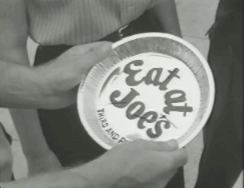 printed on the aluminum pie plate was his business card. printed on the aluminum pie plate was his business card.
Such stunts were reenacted in the Al Chop Story, left, The True Story of UFOs, 1956. (Also titled UFOs: The True Story of Flying Saucers)
Then in early July 1947 a tempting reward was posted by three business concerns, each offering $1,000 dollars. It was a collective $3,000 bucks to the person who could bring in a piece of a saucer. Little saucers were being presented as the real thing, and some were left by pranksters for others to discover in a field, or wherever, and bear the ridicule for bringing it in. Pieces of downed weather balloons, as in a case in Ohio, were also getting reported as remnants of a flying saucer.
Frankly, within the first couple of weeks of the phenomenon no one really knew what the saucers were. There was no real estimate of their size. As far as the general public could envision, flying saucers were small discs skimming through the air, and this is what largely inspired the pranksters.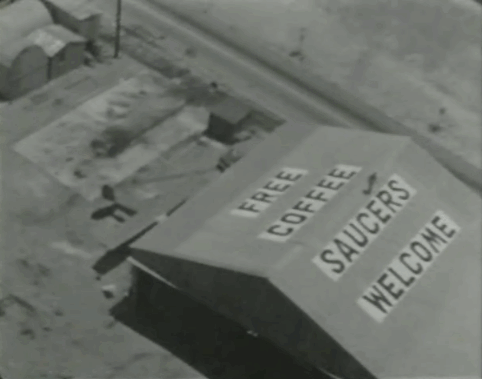
It also inspired a rancher in New Mexico named Mac Brazel to think one of these had come down on his property. Scattered over a section of it there was shiny debris, balsa sticks, bright tinfoil and some “rather hard paper,” but from the pieces it seemed some sort of disc could be assembled that was about the size of a round dining table. He first found it on June 14, but he had made nothing of it until he went into the small town of Corona in early July. After hearing talk of flying discs, he went back and collected as much of it as he could. All in all, the shredded rubber, tinfoil, sticks, and hard paper made up a bundle that weighed about 5 pounds. There was a lot of scotch tape on it, some with flowers printed on it. He put it in a shed.
On Monday July 7, he came into Roswell with a little of it and told sheriff George Wilcox about it. He in turn informed Roswell Army Air Force Base. The base, in turn, assigned the intelligence officer Major Jesse Marcel to go pick it up. He and another man went, leaving about 3:30 or 4 p.m. that day. They picked up the remaining debris over the field (which Brazel hadn’t yet gathered) and brought it back into Roswell. An “eager” PIO (Public Information Officer) at the base, Lieutenant Walter Haut, issued a release on July 8 saying they had a disc. It was really quite innocent enough. No one knew what the discs really were. Roswell AAFB had aced everybody else in the national challenge to locate one!
The many rumors regarding the flying discs became a reality yesterday when the Intelligence office of the 509th Bomb Group of the Eighth Air Force, Roswell Army Air Field, was fortunate enough to gain possession of a disc through the cooperation of one of the local ranchers and the sheriff’s office of Chaves County. The flying object landed on a ranch near Roswell sometime last week. Not having phone facilities, the rancher stored the disc until such time as he was able to contact the sheriff’s office, who in turn notified Maj. Jesse A. Marcel of the 509th Bomb Group Intelligence Office. Action was immediately taken and the disc was picked up at the rancher’s home. It was inspected at the Roswell Army Air Field and subsequently loaned by Major Marcel to higher headquarters.
Everything about the press release reflected the current impression about the flying discs. It was essentially large enough for Mac Brazel to pick up and put in his shed. Later, when recalling these events to the Roswell Daily Record on July 9, the reporter wrote:
Brazel said that he did not see it fall from the sky and did not see it before it was torn up, so he did not know the size or shape it might have been, but he thought it might have been about as large as a table top. The balloon which held it up, if that was how it worked, must have been about 12 feet long, he felt, measuring the distance by the size of the room in which he sat. The rubber was smoky gray in color and scattered over an area about 200 yards in diameter.
There should be little doubt that this is the impression Brazel gave George Wilcox and Major Jesse Marcel when he first came into Roswell on July 7. Only Marcel and an assistant were sent to pick up the disc or its remains, which means no one at Roswell AFB was given the impression this was a crash of a large manned vehicle.
A disc. A disc of any size was the big deal. America wanted to know what these things were. The first Roswell Daily Record report (on July 8) need only state “the disk was recovered on a ranch in the Roswell vicinity, after an unidentified rancher had notified Sheriff Geo. Wilcox here, that he had found the instrument on his premises” in order to set off waves of interest. Roswell news outlets were receiving calls from news agencies all over the world, as far apart as London and Hong Kong.
The disc, however, proved quite a disappointment. It did not turn out to be solid and intact. It was nothing but shredded remains. It was piled in a bomber and flown to Fort Worth, Texas, to Carswell AFB. A press conference with General Roger Ramey revealed that this was nothing but the radar reflector on a weather balloon. It wasn’t one of the genuine flying saucers!— whatever they were. A photographer 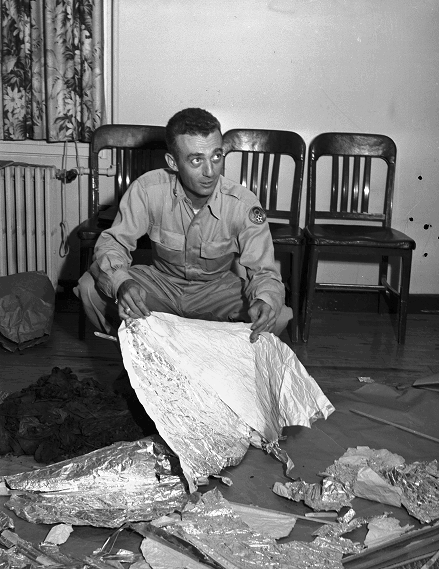 came in (J. Bond Johnson) and took about 4 pictures with Ramey near the stuff scattered on the floor, his adjutant Col. Dubose, and two with Marcel holding a piece of it. At one point, when reporters were present, Warrant Officer Irving Newton, the weather forecaster for the Army Air Force, came in and identified it for the press as the remnants of a weather observation balloon. From the pictures and the general description of the events at Roswell, there was no reason not to accept the story. came in (J. Bond Johnson) and took about 4 pictures with Ramey near the stuff scattered on the floor, his adjutant Col. Dubose, and two with Marcel holding a piece of it. At one point, when reporters were present, Warrant Officer Irving Newton, the weather forecaster for the Army Air Force, came in and identified it for the press as the remnants of a weather observation balloon. From the pictures and the general description of the events at Roswell, there was no reason not to accept the story.
Marcel, right, holds some of the debris.
Sighting after sighting of silver discs in the atmosphere continued. Flying saucer mania escalated throughout the nation and then world, and without evidence their nature and origins continued to remain quite ambiguous. Roswell was easily forgotten, but the idea of saucer crashes remained.
Frank Scully’s 1950 bestseller Behind the Flying Saucers went into details about how in 1948 three flying saucers had crashed, two in New Mexico (one near Aztec) and one in Arizona. He asserted he was hearing it straight from one of the scientists involved in the recovery. Scully called him “Dr. Gee,” and said he had more “degrees than a thermometer.” He turned out to be a con artist and hardware dealer named Leo Gebauer who along with his buddy Silas Newton were peddling some gadgetry they said had been inspired by the flying saucer technology. In 1952, Scully’s book was exposed for its inaccuracy by J.P. Cahn in a scathing True magazine article. The entire idea of crashed saucers in the Southwest faded away. It faded away for decades.
The first inkling of renewed interest in Roswell came through the UFO grapevine. And this brings us to Leonard H. Stringfield. He was an ardent UFO investigator, well known in the field since the beginning as one of the most dedicated civilian researchers. By the mid 1970s he had taken up a specialty interest in the field— crashed, recovered discs and their alien occupants. This interest arose because witnesses/informants naturally told him some of their stories of alien beings. He was always interested in the story of aliens themselves, and in 1957 had published Inside Saucer Post . . .3.0 Blue dealing with contacts with little men. Then the stories expanded to include dead ones behind closed Air Force doors. He began to compile the stories. Some appeared in his Situation Red, 1977, and then a couple of dozen were given an overview in his special paper Retrievals of the Third Kind presented at the MUFON UFO Symposium in Dayton, Ohio, in July 1978. This was in turn published in Flying Saucer Review in 3 parts, beginning in the July-August issue in 1979.
Roswell didn’t rate much, and it wasn’t even introduced until part 3. One can imagine it didn’t rate much interest because Stringfield’s focus of interest was crashed saucers and alien bodies. The informant in the case, a Major J.M. in Houma, Louisiana, had said there was nothing like that. The case was introduced as Abstract XVIII The recovery of metallic fragments of unusual strength. The interview with “Major J.M.” had come about over the phone, with Chicago NBC radio newsman Steve Tom listening in. Both listened to Marcel privately tell his story on April 7, 1978. He told them he had been an intelligence officer back at Roswell AAFB in 1947 and he had been delegated to pick up these unusual remains on a rancher’s land. Stringfield always protected his informants in his published material, often just by using their initials. It is a powerful testimony to how Roswell had been forgotten that Marcel could be written up merely as Major J.M.
Compared to the other cases listed in Stringfield’s long paper, Roswell wasn’t much of anything. For two installments Stringfield had mentioned many intriguing cases. Most actually dated to the early 1950s. (He had opened with one case in 1948, but the “informant” was clearly inspired by Scully’s old exposed rubbish.) Each case was based on witnesses who had come forward to him directly or through “unquestionable” sources. Each case spoke of the crash of a saucer or that such a saucer and/or the dead bodies of little men were seen at Wright-Patterson AFB, in Dayton, Ohio.
In terms of published material, Stringfield’s work via his unnamed informants is the bedrock of the entire genre of UFO crashes, recovered bodies, and forbidden recesses at Wright-Patterson AFB. But though the Roswell information was basically anemic by comparison to the other tales, it had something the others didn’t have. It had a basis in published accounts in 1947. The others were merely from unnamed witnesses to behind-the-scenes events that had never rated news.
Stanton Friedman, the only professional UFOlogist, had realized this as well and gave it priority. He talked to Marcel. Marcel stuck to his story. He insisted he didn’t know what had crashed near Roswell. But there was a certainty about Marcel’s conviction. He was sure that the stuff he picked up wasn’t anything they knew about. There was too much of it to be a weather balloon’s remains. He went on to repeat his certainty with great conviction on a local Louisiana TV documentary, then on UFOs Are Real, 1979, on which Friedman was a significant consultant. The probability of a saucer crash at Roswell hinges on Marcel’s memory and his personal conviction.
From UFOs Are Real:
One thing I was certain of, being familiar with all air activities, that it was not a weather balloon, nor an aircraft, nor a missile. It was something else of which we didn’t know what it was. There were just fragments strewn all over the area; an area of about three quarters of a mile long and several hundred feet wide. So we proceeded to pick up the parts. A lot of it had a lot of little members with symbols that to me I call them hieroglyphics because I could not interpret them. They could not be read. They were just like symbols. Something that meant something. These little members could not be broken. They could not be burned. I even tried to burn that. It would not burn. See, that stuff weighs nothing. It’s not any thicker than the tinfoil in a pack of cigarettes. See, I tried to bend the stuff. Still it will not bend. We did all we could to bend it. Still it would not bend. We even tried making a dent in it with a 16 pound sledge hammer. Still no dent in it.
Regarding the press conference in Fort Worth:
The newsmen saw very little of that material, very small portion of it. And none of the important things like these members that had these hieroglyphics or markings on them. They wanted me to tell them about it, and I couldn’t say anything. And when the general came in he told me not to say anything, that he would handle it.
Marcel spoke with equal conviction for a very large TV audience when in Season 5 (first episode of the season) he appeared in “UFO Coverups” on In Search of . . . He had returned to Roswell to reenact the day’s events of 33 years before. Standing in the field of the crash on the old Brazel ranch, he reflected back at the Fort Worth news conference:
They took pictures, of course. They had a whole flock of microphones there. They wanted some comments from me, but I wasn’t at liberty to do that. So all I could do is keep my mouth shut. And General Ramey is the one who told the newsmen what it was and to forget about it. It was nothing more than a weather observation balloon, of course of which we both new differently.
Driving in a jeep to the crash location, he said:
“We left Roswell around perhaps 3:30 or 4 o’clock in the afternoon. And you can see it’s flat. It is very difficult— in fact with just verbal directions we never would have found it. We had to follow the rancher out there.” Arriving at and walking in the field: “The following morning we went out to the site where the crash was. And what I saw I couldn’t believe— there was so much of it. It was scattered over such a vast area. So we proceeded to pick up as much of the debris as we could and load it in a wagon. We filled that up— took us a good part of a day to do that ’cause there was such small fragments, and we had to do a lot of picking.
We found a piece of metal about a foot and half to 2 feet wide and about 2 or 3 feet long. It felt like you have nothing in your hand. It wasn’t any thicker than the foil out of a pack of cigarettes. But the thing about it that got me is you couldn’t even bend it. You couldn’t dent it, even with a sledge hammer it would bounce off it. So I knew I had never seen anything like that before. And as of now I don’t know what it was.”
Later in conclusion, standing in the field: “It was not anything from this Earth, of that I am quite sure of. ’Cause being an intelligence officer I was familiar with just about every— all materials used in aircraft 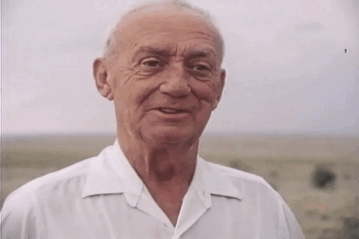 and or air travel. This was nothing like that. It could not have been. It could not have been.” and or air travel. This was nothing like that. It could not have been. It could not have been.”
Jesse Marcel was honest, and he wouldn’t budge. He saw no bodies or a spaceship. It was this strange material that defied description. And they saw so much of this strange lightweight material. There was too much of it to be from the reflector on a weather balloon.
Stanton Friedman was the main source of much of what Charles Berlitz and William L. Moore would publish in The Roswell Incident in 1980. It became a bestseller and from there it expanded in the hands of other authors, such as Kevin Randle and Don Schmitt in UFO Crash at Roswell, 1991. Finally, in 1992 Friedman would publish Crash at Corona with co-author Don Berliner. Friedman’s book was the culmination of the ultimate investigator’s own research.
Friedman’s book was highly anticipated. He had long been sharing some of his discoveries and their vast implications for over a decade. For instance, at the MUFON Conference in July 1981 (Cambridge, Mass) he had delivered a 22 page paper entitled “Roswell: Beginnings of a Cosmic Watergate.” He had introduced the catchy concept at his speaking engagements and then nationally introduced it on UFOs Are Real in 1979.
“In the course of lecturing all over the continent, I have talked now to more than 90 former military people who have told me of excellent sightings that occurred while they were in the Service and where the data didn’t go to the old Project Blue Book, which we were told was the only government group concerned with UFOs, but instead typically went to the Aerospace Defense Command or the National Security Agency, and where the security lid was clamped down immediately. Now, I’ve heard so many of these stories that I’m either having to say that all these people are lying or that we are dealing with a cosmic Watergate.”
The statement above conveniently explained why the Project Blue Book material held no conclusive cases proving UFOs. (The records of the once highly publicized investigation had been released in 1975.) In the same documentary (UFOs Are Real) Friedman had also said that he talked to over 2 dozen eyewitnesses in New Mexico alone, and that every word Marcel had said has been verified.
Yet verifying Marcel’s words about fragments didn’t prove a crashed saucer. It was Marcel’s conviction the material was “not of this world” that convinced Friedman there had been a crash somewhere else. When extraneous witnesses to the Roswell story (fragments, etc.) insisted they had heard of a crashed saucer and alien bodies, Friedman knew the lack of records and the constant official denials meant a coverup, a heinous and vast one concealing the earth-shattering fact that aliens did exist and had visited earth. The UFO coverup and conspiracy was thus far reaching. After the Roswell scenario caught fire in 1980, it became the beginning point of his catchy “Cosmic Watergate.”
The significance of a crash at Roswell was especially important at this time. In 1980, the UFO phenomenon was 33 years old and still lacked proof. It had gone through ups and downs of sensation and public interest, most recently in 1973 with a UFO flap over the southeast, and significantly over 1965-’67, in which Congress got involved, then the Condon Committee was convened to study the phenomenon. The flap was also pivotal in causing the stoic J. Allen Hynek, the Air Force’s own official scientific expert, to convert to belief in UFOs. All of this sweetened the pot, but none of this was proof. A crash was proof, and Friedman wasn’t pulling the concept of one out of thin air (no pun intended). He had material to work with— the memory of those who recalled bits and pieces of the news reports from 1947. But most of all, he had the man at the central part of a published news story 33 years before— Jesse Marcel. And Marcel spoke with conviction.
But Marcel’s memory and conviction are finite. Both apply only to his impression of what they found in the field. It is clear that neither he nor anyone at Roswell on July 7, 1947, had any impression that saucers were anything but discs of undetermined size. After all, only he and one man went to pick up the stuff. When it turned out to be too much to be from a radar reflector on a weather balloon, Marcel got curious. Over the years, it must have been the amount of debris that stuck in his mind. He didn’t know what to make of it. We can imagine the event that began him thinking anew—
—In October 1974 national interest skyrocketed in the concept of a crashed saucer. A NICAP flunky, Robert Spencer Carr, insisted that from three impeccable sources he knew that a saucer crash had occurred in New Mexico in 1948 and that the bodies had been taken to Wright-Patterson Field and put in Hangar 18. Carr, a voluble retired professor of mass communication at U of South Florida, seemed respectable enough. Although exposed as having been largely inspired by nothing more than Scully’s old debunked 1950 book, Behind the Flying Saucers, Carr’s bold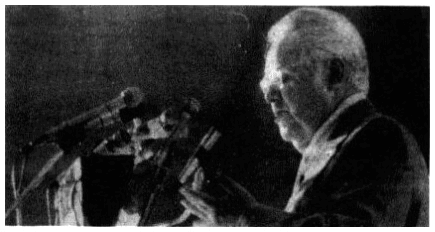 assertions and bald face lies kept him afloat through hundreds of radio shows and speaking engagements. Even if UFOlogy and the tabloid media would slowly excise him from the story, they still retained the general concept. assertions and bald face lies kept him afloat through hundreds of radio shows and speaking engagements. Even if UFOlogy and the tabloid media would slowly excise him from the story, they still retained the general concept.
Carr at a highly publicized presentation in Tampa.
Memory over the years perhaps had exaggerated in Marcel’s mind how unusual the stuff at Roswell was. Thus he now came to believe he had been a part of something truly strange. The problem is, he didn’t know about Project Mogul. This balloon carried 4 reflectors to high altitude in order to detect Soviet atomic tests. Marcel even slipped in his In Search of clip. “’cause being an intelligence officer I was familiar with just about every— all materials used in aircraft and/or air travel. This was nothing like that.” He caught himself at “about every” and quickly said “all.” He wasn’t familiar with “all,” especially a top secret experiment. He also didn’t want to compromise his new found authority on the subject.
No matter how many “witnesses” about Roswell came out of the woodwork thereafter, everything hinges on Marcel. Reading Stringfield’s Retrievals of the Third Kind and comparing it to later published works by the Roswell clan of writers is to underscore the truth of this statement. It is plain to see that Stan Friedman tried to link the other, completely unconnected accounts of people having seen bodies and saucers at Wright-Patterson to the Roswell crash. There was no such inference in Stringfield’s work. His witnesses stated plainly their encounters occurred in the early 1950s or later.
Stringfield’s Retrievals is significant here for three major reasons. (1) His Retrievals came a few years after Carr had ignited the concept of crashed saucers. (2) Some of Stringfield’s unnamed sources about bodies and Wright-Patterson AFB might have been inspired by Carr’s statements, but it is most significant (3) that no informants came forward in those years (after Carr spiked the public interest and before Marcel’s debut on the world stage) informing Carr or Stringfield of anything at Roswell or any crash in 1947 at all.
Carr would tell Stringfield (in Retrievals, 1978) that the 1948 Aztec, New Mexico, case was the “ancestor” of them all. Stringfield’s Retrievals preserve for us that Roswell remained nothing but a pathetic and ambiguous report of unidentified fragments even years after Carr excited the world. If Roswell had been real, why didn’t the eyewitnesses come forward now? Those that came forward came forward only to support Carr’s story of Hangar 18 and Wright-Patterson. Others came forward to inform Stringfield of any case but Roswell.
And no matter how hard ardent believers try and circumnavigate their way around the original Roswell news releases, it is obvious that the disc was thought to be something small. Only two men went to pick up the remains, and Brazel said he thought it could form a round tabletop. Stringfield’s first original crashed saucer stories are all from the early 1950s, and he rightly made little out of fragments at Roswell.
Between 1947 and 1980, UFOlogy had evolved with chapters of interest. Sightings reports, which were the basis of 1950s’ books, had gotten old. Landings became popular in the 1960s. Hypnosis and alien abductions became incredibly popular in the funky, broadminded 1970s. Roswell and crashed saucers and devious government coverups became the fare of the 1980s. One chapter gets old, another must take its place. UFOlogy by this time needed a new chapter, and facts buried in the deep vault of history and interpretation of misty memories was perfect.
Conspiracies of memory can never be proved. An ending to such a chapter could never be written. Alien crashes and omnipotent coverups is the perfect cash cow.
But Roswell survives not just because an ending can’t be written. It had a very definite and publicized beginning, and Marcel was boldly proclaiming a coverup had happened. His story was actually the perfect beginning. Marcel could not be so authoritative he could control the thesis’ evolution. He saw no wreck. He could only infer a crash. Bodies and an actual saucer had to be found elsewhere. Thus enters the meat and bones of the Roswell story. Everything was in the hands of the UFO researchers to mold into the place they wanted.
Although for years no one had come forward to Carr or Stringfield, Friedman was able to thrash out of the desert brush 91 extraneous witnesses whose stories he could piece into a patchwork quilt around the single square provided by Marcel. (This figure was declared in June 1985 at the MUFON Conference, St. Louis, MO., by William L. Moore, who said since 1978 he and Friedman had interviewed such a number of claimants.)
Fortunately, some of the above 91 witnesses had said there were bodies and an entire spaceship recovered elsewhere. Friedman opted to propose that the saucer had been damaged near Roswell over Brazel’s ranch but continued on and crashed near Corona, 30 miles away, hence the name of his book Crash at Corona. Maybe two had collided, and thus this could explain the reports of a crashed saucer elsewhere (at San Augustin)— more saucers, more bodies! All in 1947 now! As more and more claimants came forward, the amount of debris at Brazel’s ranch grew to fill more than one plane load. It seemed too much for just one saucer.
Part of the evolving story of Roswell is testimony by a former civilian mortician, Glenn Dennis, who said there had been autopsies and bodies whisked away in airtight cylinders to Wright-Patterson Air Force Base in Ohio. This fit with the legend established by Stringfield for other saucer crashes. It was Berlitz and Moore who abscond with it in their 1980 book The Roswell Incident. and apply it to the crash at Roswell. To 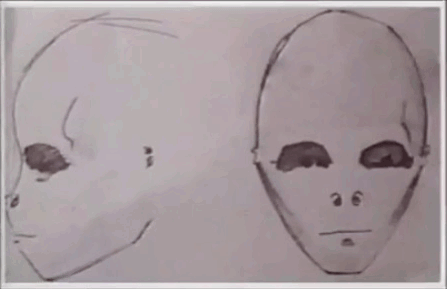 this highly classified base in Ohio, so the legend has it thanks to Robert Spencer Carr (for an entirely different incident anyway) also went the flying saucer in 1947, delivered and locked away in mysterious Hangar 18. this highly classified base in Ohio, so the legend has it thanks to Robert Spencer Carr (for an entirely different incident anyway) also went the flying saucer in 1947, delivered and locked away in mysterious Hangar 18.
The sketches, right, are purportedly from the eyewitness who did autopsy work on the bodies. They are obviously inspired by the Betty and Barney Hill prototypes and the sketch in Berlitz and Moore’s book (below, right) drawn by Len Stringfield, which itself was inspired by the Barney Hill prototype.
It is more than the context of July 7, 1947, that undermines Roswell’s credibility in the 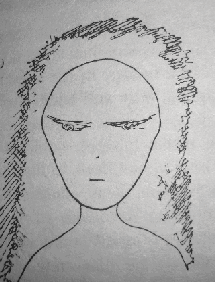 UFO “experience.” It is the evolving chapters of the marketing of UFOs that undermine the Roswell myth as it has grown today. The Roswell aliens are shown to look like those recalled in very questionable regressive hypnosis sessions with Barney Hill in 1964. This image caught on with the UFO crowd from John Fuller’s 1966 book The Interrupted Journey. Then it caught on with the public in a successful Movie of the Week in 1975: The UFO Incident. Stringfield’s informants recalled this image in general after 1975, and he finally drew a sketch based on all he had heard. Although Berlitz and Moore present it in their book, it was published previously in Stringfield’s works and really has nothing to do with Roswell. Stringfield had made no association with Roswell, of course, since it was only a minor case with no bodies or craft. Berlitz and Moore made it look like the Roswell aliens. There is no other basis for the alien image than this. UFO “experience.” It is the evolving chapters of the marketing of UFOs that undermine the Roswell myth as it has grown today. The Roswell aliens are shown to look like those recalled in very questionable regressive hypnosis sessions with Barney Hill in 1964. This image caught on with the UFO crowd from John Fuller’s 1966 book The Interrupted Journey. Then it caught on with the public in a successful Movie of the Week in 1975: The UFO Incident. Stringfield’s informants recalled this image in general after 1975, and he finally drew a sketch based on all he had heard. Although Berlitz and Moore present it in their book, it was published previously in Stringfield’s works and really has nothing to do with Roswell. Stringfield had made no association with Roswell, of course, since it was only a minor case with no bodies or craft. Berlitz and Moore made it look like the Roswell aliens. There is no other basis for the alien image than this.
The flying saucer that crashed at Roswell has also morphed, sometimes comically. As actually sighted in the atmosphere in 1947, the original saucers were oval discuses. After 1950, popular culture made them circles with domes on top. One witness to a crash in New Mexico gave Randle and Schmitt (UFO Crash 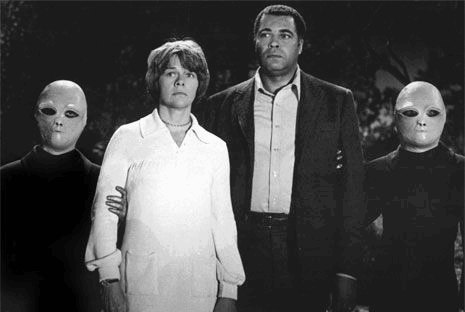 at Roswell) a crude drawing showing what the saucer looked like— it was an upended disc with a dome. at Roswell) a crude drawing showing what the saucer looked like— it was an upended disc with a dome.
Promo for The UFO Incident starring Estelle Parsons and James Earl Jones, 1975.
Debunkers sought to present evidence that would prove there was no crash near Roswell. This was found extrinsically in released documents under the Freedom of Information Act, which showed that military officers and CIA scientists who should have been in-the-know were completely skeptical about the existence of flying saucers, a skepticism they wouldn’t have if they had one in a locker somewhere.
It became a quote game and a documents game. Pro Roswellers presented an old memo from E.G. Fitch to D.M. Ladd at the FBI. General George Schulgen of Army Intelligence wanted the FBI to investigate the flying saucers that were being recovered. Ladd wrote to Director J. Edgar Hoover:
“I would recommend that we advise the Army that the Bureau does not believe it should go into these investigations, it being noted that a great bulk of those alleged discs reported found have been pranks [emphasis mine]. It is not believed that the Bureau would accomplish anything by going into these investigations.”
Clyde Tolson, Hoover’s assistant, hand penned on the memo: “I think we should do this,” and then hand dated his comment.
Hoover read the memo and hand annotated his response: “I would do it but before agreeing to it we must insist upon full access to discs recovered. For instance in the [La?] case the Army grabbed it and would not let us have it for cursory examination.”
The memo was typed up on July 10, 1947. With this we come back to the early two weeks of the saucer phenomenon. These small discs were popping up all over, thanks to the $3,000 smackerals reward, and as Ladd cautions they were the result of pranksters. There was no reason for the FBI to get involved.
Nevertheless, Hoover’s response has been taken to imply that Roswell happened (and other crashes) and that the Army kept the FBI in the dark. The context is actually the small discs that were being made by pranksters. The news was full of this sort of thing, one reason perhaps why Brazel thought the small amount of debris he had on his ranch could be a flying disc. Remember, he had heard of these only when going into Corona and hearing the news reports of “flying discs.” Nothing in the memo or the Hoover response indicates large flying saucers with occupants aboard.
It is a logistic impossibility for the FBI to investigate saucer reports. But tangible objects are something the Bureau could examine, analyze the metal and find out where it was manufactured. The Army fear (Schulgen’s) that these could have been revolutionary devices made by the Soviets certainly made a request to the FBI practical.
Like ancient folklore of the gods and demigods residing in groves and mountains, the idea of crashes in the desert and aliens alive or dead have evolved and become an exciting adventure. Unlike the old mythology, however, it has a scientific patina to it, and that makes it look more viable as truth. Spaceships from another planet are a possibility, so therefore is a crash and alien bodies. It’s not the stuff of myth like titans and demigods battling it out or the golden fleece residing in Colchis. Storytellers of old repeated the tales of battles between gods and titans, mortals and demigods, in ancient Greece. They were fun, heroic, and inspiring. They were full of encounters with strange beings and half human creatures. The tales were reinforced as true merely by the retelling. In like manner, those so-called documentaries today take the place of the primitive storytellers. They continue to churn out episodes. Roswell is reinforced as true merely by the retailing. . . .I mean retelling.
Yet despite a negative opinion that should surround Roswell, we cannot be sure that a saucer has not crashed elsewhere at another time. In Len Stringfield’s Retrievals, we are confronted by the accounts of many people who claim they remembered a crash of a saucer, with bodies and a wreck at Wright-Patterson AFB in the early 1950s. Were the true details of all those witnesses who talked to Friedman accurately conveyed to his reading audience? Most likely not. He was addicted to the Roswell concept and sculpted everything to fit 1947. Friedman’s use of information from Dr. Robert Sarbacher hardly showed an inductive analytical skill. The bulk of his phone conversation with him is in the public realm and it can be compared to how he wrote it up in Crash at Corona. He used Sarbacher’s information, as he did with the other informants, only to support the idea that bodies were at Wright-Patterson by 1950. Sarbacher was actually talking about a crash in the early Eisenhower Administration, coincidentally like so many of Stringfield’s unnamed informants.
Released, formerly SECRET, documents between 1947 and 1952 make it extremely hard to propose that there was any such crash of saucers prior to 1953. The Air Force remained fairly open with Donald Keyhoe (through PR man Al Chop) until things changed suddenly in the summer of 1953 and new orders were issued on August 26, declaring stiff punishments for Air Force men and officers who let their UFO sightings leak to the public. The significance of this is explored at The Sarbacher Clue to which we must now go. It is time to start PHASE 2 and our own and hopefully correct path to the present.
|